Microscope the condenser - Study guides, Class notes & Summaries
Looking for the best study guides, study notes and summaries about Microscope the condenser? On this page you'll find 439 study documents about Microscope the condenser.
Page 2 out of 439 results
Sort by
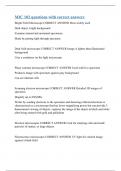
-
MIC 102 questions with correct answers
- Exam (elaborations) • 23 pages • 2023
- Available in package deal
-
- $21.49
- + learn more
Bright Field Microscope CORRECT ANSWER Most widely used Dark object, bright background Examine stained and unstained specimens Made by putting light through specimen Dark field microscope CORRECT ANSWER Image is lighter than illuminated background Uses a condenser on the light microscope Phase contrast microscope CORRECT ANSWER Used with live specimen Produces image with specimen against gray background Can see internal cells Scanning electron microscope CORRECT ANSWER Detailed 3D...
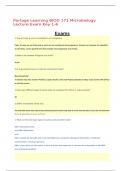
-
Portage Learning BIOD 171 Microbiology Lecture Exam Key 1-6
- Exam (elaborations) • 28 pages • 2023
- Available in package deal
-
- $14.49
- 1x sold
- + learn more
Portage Learning BIOD 171 Microbiology Lecture Exam Key 1-6 Exams 1. What are the two major types of nucleic acids and their roles? DNA- deoxyribonucleic acid RNA- Ribonucleic acid DNA- Cellular life has DNA and a role that DNA has is long-term storage of information, it holds the characteristics of living organisms. RNA- Is the carrier of information in form of amino acid sequence. It converts the information in the DNA and synthesizes proteins Tru...
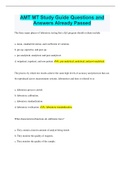
-
AMT MT Study Guide Questions and Answers Already Passed
- Exam (elaborations) • 196 pages • 2022
- Available in package deal
-
- $10.49
- 1x sold
- + learn more
AMT MT Study Guide Questions and Answers Already Passed The three major phases of laboratory testing that a QA program should evaluate include a. mean, standard deviation, and coefficient of variation. b. pre-op, operative, and post-op. c. pre-analytical, analytical, and post-analytical. d. outpatient, inpatient, and non-patient. c. pre-analytical, analytical, and post-analytical. The process by which test results achieve the same high levels of accuracy and precision that can be reproduced...
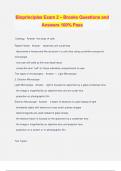
-
Bioprinciples Exam 2 – Brooks Questions and Answers 100% Pass
- Exam (elaborations) • 42 pages • 2024
-
- $13.49
- + learn more
Bioprinciples Exam 2 – Brooks Questions and Answers 100% Pass Cytology - Answer- the study of cells Robert Hooke - Answer- - observed cork could float - discovered a honeycomb-like structure in a cork slice using a primitive compound microscope - only saw cell walls as this was dead tissue - coined the term "cell" for these individual compartments he saw Two types of microscopes: - Answer- 1. Light Microscope 2. Electron Microscope Light Microscope - Answer- - light is focused on s...
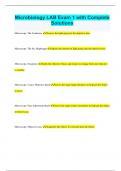
-
Microbiology LAB Exam 1 with Complete Solutions
- Exam (elaborations) • 22 pages • 2024
- Available in package deal
-
- $9.99
- + learn more
Microbiology LAB Exam 1 with Complete Solutions Microscope- The Condenser focuses the light ging into the objective lens Microscope- The Iris Diaphragm adjusts the amount of light going into the objective lens Microscope- Nosepiece holds the objective lenses and rotates to change from one objective to another Microscope- Coarse Objective Knob moves the stage larger distances to help get the object in focus Microscope- Fine Adjustment Knob moves the stage smaler increments to help get the obj...
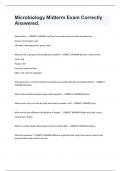
-
Microbiology Midterm Exam Correctly Answered.
- Exam (elaborations) • 26 pages • 2024
- Available in package deal
-
- $10.99
- + learn more
Microbiology Midterm Exam Correctly Answered. Define Micro- - CORRECT ANSWER Less than 1mm and cannot see with the naked eye Need a microscope to see Microbes, microorganisms, germs, bugs What are the 5 groups of microorganisms studied? - CORRECT ANSWER Bacteria--most famous Virus--2nd Fungus--3rd Protozoa--some but few Algae--not a human pathogen What generates 1/2 of the O2 that we breathe and would make life impossible without? - CORRECT ANSWER Microbes What is the smalles...
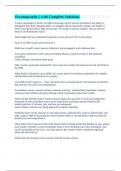
-
Oceanography || with Complete Solutions.
- Exam (elaborations) • 18 pages • 2024
- Available in package deal
-
- $13.29
- + learn more
3 major advantages of SEM over light microscope correct answers Resolution: the ability to distinguish fine detail, Magnification: can magnify objects thousands of times, and Depth of Field: much greater than a light microscope. 3-D image of surface samples. Uses an electron beam as its illumination source What length unit was mentioned frequently correct answers UM or micrometer Parts of an SEM correct answers Know it What lens is used? correct answers Objective, electromagnetic and co...
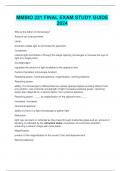
-
MMBIO 221 FINAL EXAM STUDY GUIDE 2024
- Exam (elaborations) • 20 pages • 2024
- Available in package deal
-
- $13.99
- + learn more
Who is the father of microscopy? Antonie van Leeuwenhoek Lamp: produces visible light to illuminate the specimen Condenser: collects light and directs it through the stage opening (converges or focuses the rays of light to a single point) Iris diaphragm: regulates the amount of light available to the objective lens Factors that affect microscope function: Resolving power, numerical aperture, magnification, working distance Resolving power: ability of a microscope to differentiate two ...
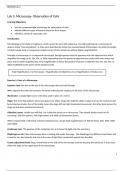
-
BIOS 242 Week 2 Assignment; Lab 3 of 14 Onsite; Microscopy Observation of Cells
- Other • 10 pages • 2024
-
- $9.99
- + learn more
BIOS 242 Week 2 Assignment; Lab 3 of 14 Onsite; Microscopy Observation of Cells Lab 3: Microscopy- Observation of Cells Learning Objectives: Use the compound light microscope for observation of cells. Identify different types of bacteria based on their shapes. Identify a variety of eukaryotic cells. Introduction: Microbiology is the study of organisms, which cannot be seen with naked eye. You will need help of a microscope to observe these “tiny animalcules” as they w...
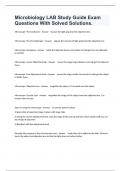
-
Microbiology LAB Study Guide Exam Questions With Solved Solutions.
- Exam (elaborations) • 13 pages • 2024
-
- $9.99
- + learn more
Microscope- The Condenser - Answer focuses the light ging into the objective lens Microscope- The Iris Diaphragm - Answer adjusts the amount of light going into the objective lens Microscope- Nosepiece - Answer holds the objective lenses and rotates to change from one objective to another Microscope- Coarse Objective Knob - Answer moves the stage larger distances to help get the object in focus Microscope- Fine Adjustment Knob - Answer moves the stage smaler increments...

How did he do that? By selling his study resources on Stuvia. Try it yourself! Discover all about earning on Stuvia


